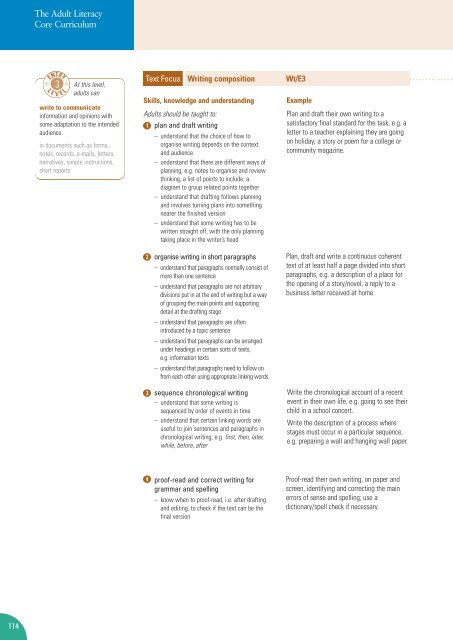Adult Literacy Core Curriculum - Nationally developed Skills for Life ...
Adult Literacy Core Curriculum - Nationally developed Skills for Life ...
Adult Literacy Core Curriculum - Nationally developed Skills for Life ...
Create successful ePaper yourself
Turn your PDF publications into a flip-book with our unique Google optimized e-Paper software.
114<br />
The <strong>Adult</strong> <strong>Literacy</strong><br />
<strong>Core</strong> <strong>Curriculum</strong><br />
At this level,<br />
adults can<br />
write to communicate<br />
in<strong>for</strong>mation and opinions with<br />
some adaptation to the intended<br />
audience<br />
in documents such as <strong>for</strong>ms,<br />
notes, records, e-mails, letters,<br />
narratives, simple instructions,<br />
short reports<br />
Text Focus Writing composition Wt/E3<br />
<strong>Skills</strong>, knowledge and understanding<br />
<strong>Adult</strong>s should be taught to:<br />
1 plan and draft writing<br />
– understand that the choice of how to<br />
organise writing depends on the context<br />
and audience<br />
– understand that there are different ways of<br />
planning, e.g. notes to organise and review<br />
thinking, a list of points to include, a<br />
diagram to group related points together<br />
– understand that drafting follows planning<br />
and involves turning plans into something<br />
nearer the finished version<br />
– understand that some writing has to be<br />
written straight off, with the only planning<br />
taking place in the writer’s head<br />
2<br />
3<br />
4<br />
organise writing in short paragraphs<br />
– understand that paragraphs normally consist of<br />
more than one sentence<br />
– understand that paragraphs are not arbitrary<br />
divisions put in at the end of writing but a way<br />
of grouping the main points and supporting<br />
detail at the drafting stage<br />
– understand that paragraphs are often<br />
introduced by a topic sentence<br />
– understand that paragraphs can be arranged<br />
under headings in certain sorts of texts,<br />
e.g. in<strong>for</strong>mation texts<br />
– understand that paragraphs need to follow on<br />
from each other using appropriate linking words<br />
sequence chronological writing<br />
– understand that some writing is<br />
sequenced by order of events in time<br />
– understand that certain linking words are<br />
useful to join sentences and paragraphs in<br />
chronological writing, e.g. first, then, later,<br />
while, be<strong>for</strong>e, after<br />
proof-read and correct writing <strong>for</strong><br />
grammar and spelling<br />
– know when to proof-read, i.e. after drafting<br />
and editing, to check if the text can be the<br />
final version<br />
Example<br />
Plan and draft their own writing to a<br />
satisfactory final standard <strong>for</strong> the task, e.g. a<br />
letter to a teacher explaining they are going<br />
on holiday; a story or poem <strong>for</strong> a college or<br />
community magazine.<br />
Plan, draft and write a continuous coherent<br />
text of at least half a page divided into short<br />
paragraphs, e.g. a description of a place <strong>for</strong><br />
the opening of a story/novel, a reply to a<br />
business letter received at home.<br />
Write the chronological account of a recent<br />
event in their own life, e.g. going to see their<br />
child in a school concert.<br />
Write the description of a process where<br />
stages must occur in a particular sequence,<br />
e.g. preparing a wall and hanging wall paper.<br />
Proof-read their own writing, on paper and<br />
screen, identifying and correcting the main<br />
errors of sense and spelling; use a<br />
dictionary/spell check if necessary.

















